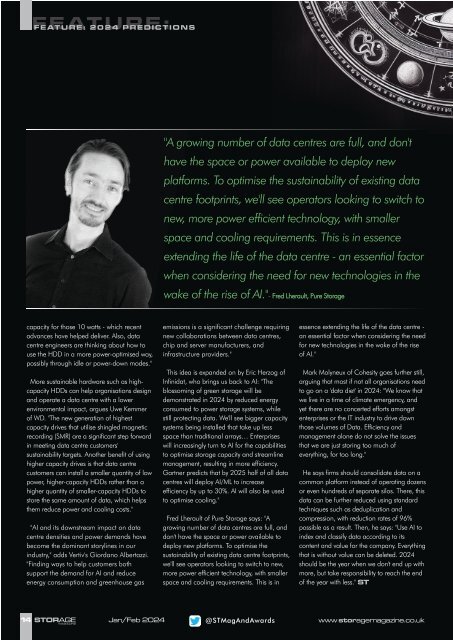ST2401
Create successful ePaper yourself
Turn your PDF publications into a flip-book with our unique Google optimized e-Paper software.
FEATURE:<br />
FEATURE: 2024 PREDICTIONS<br />
"A growing number of data centres are full, and don't<br />
have the space or power available to deploy new<br />
platforms. To optimise the sustainability of existing data<br />
centre footprints, we'll see operators looking to switch to<br />
new, more power efficient technology, with smaller<br />
space and cooling requirements. This is in essence<br />
extending the life of the data centre - an essential factor<br />
when considering the need for new technologies in the<br />
wake of the rise of AI."- Fred Lherault, Pure Storage<br />
capacity for those 10 watts - which recent<br />
advances have helped deliver. Also, data<br />
centre engineers are thinking about how to<br />
use the HDD in a more power-optimised way,<br />
possibly through idle or power-down modes."<br />
More sustainable hardware such as highcapacity<br />
HDDs can help organisations design<br />
and operate a data centre with a lower<br />
environmental impact, argues Uwe Kemmer<br />
of WD. "The new generation of highest<br />
capacity drives that utilise shingled magnetic<br />
recording (SMR) are a significant step forward<br />
in meeting data centre customers'<br />
sustainability targets. Another benefit of using<br />
higher capacity drives is that data centre<br />
customers can install a smaller quantity of low<br />
power, higher-capacity HDDs rather than a<br />
higher quantity of smaller-capacity HDDs to<br />
store the same amount of data, which helps<br />
them reduce power and cooling costs."<br />
"AI and its downstream impact on data<br />
centre densities and power demands have<br />
become the dominant storylines in our<br />
industry," adds Vertiv's Giordano Albertazzi.<br />
"Finding ways to help customers both<br />
support the demand for AI and reduce<br />
energy consumption and greenhouse gas<br />
emissions is a significant challenge requiring<br />
new collaborations between data centres,<br />
chip and server manufacturers, and<br />
infrastructure providers."<br />
This idea is expanded on by Eric Herzog of<br />
Infinidat, who brings us back to AI: "The<br />
blossoming of green storage will be<br />
demonstrated in 2024 by reduced energy<br />
consumed to power storage systems, while<br />
still protecting data. We'll see bigger capacity<br />
systems being installed that take up less<br />
space than traditional arrays… Enterprises<br />
will increasingly turn to AI for the capabilities<br />
to optimise storage capacity and streamline<br />
management, resulting in more efficiency.<br />
Gartner predicts that by 2025 half of all data<br />
centres will deploy AI/ML to increase<br />
efficiency by up to 30%. AI will also be used<br />
to optimise cooling."<br />
Fred Lherault of Pure Storage says: "A<br />
growing number of data centres are full, and<br />
don't have the space or power available to<br />
deploy new platforms. To optimise the<br />
sustainability of existing data centre footprints,<br />
we'll see operators looking to switch to new,<br />
more power efficient technology, with smaller<br />
space and cooling requirements. This is in<br />
essence extending the life of the data centre -<br />
an essential factor when considering the need<br />
for new technologies in the wake of the rise<br />
of AI."<br />
Mark Molyneux of Cohesity goes further still,<br />
arguing that most if not all organisations need<br />
to go on a 'data diet' in 2024: "We know that<br />
we live in a time of climate emergency, and<br />
yet there are no concerted efforts amongst<br />
enterprises or the IT industry to drive down<br />
those volumes of Data. Efficiency and<br />
management alone do not solve the issues<br />
that we are just storing too much of<br />
everything, for too long."<br />
He says firms should consolidate data on a<br />
common platform instead of operating dozens<br />
or even hundreds of separate silos. There, this<br />
data can be further reduced using standard<br />
techniques such as deduplication and<br />
compression, with reduction rates of 96%<br />
possible as a result. Then, he says: "Use AI to<br />
index and classify data according to its<br />
content and value for the company. Everything<br />
that is without value can be deleted. 2024<br />
should be the year when we don't end up with<br />
more, but take responsibility to reach the end<br />
of the year with less." ST<br />
14 STORAGE Jan/Feb 2024<br />
@STMagAndAwards<br />
www.storagemagazine.co.uk<br />
MAGAZINE
















